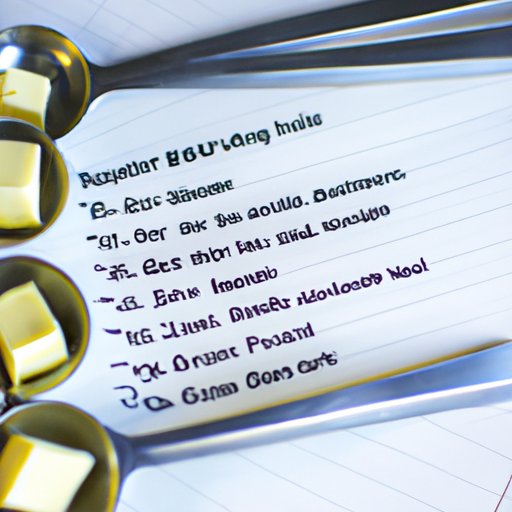Introduction
When it comes to cooking and baking, mastering accurate measurements is key to achieving delicious results. But if you’re not used to measuring butter in teaspoons, it can be tricky to know how much to use. That’s why we’ve put together this in-depth guide to help you understand how many teaspoons of butter are in a stick, and how to measure butter for all your favorite recipes.
All You Need to Know About Butter Measurements: How Many Teaspoons of Butter are in a Stick?
First things first, let’s define what a stick of butter actually is. In the United States, “a stick of butter” refers to a particular size of butter packaging that is commonly sold in stores. A stick of butter weighs 4 ounces or 113.4 grams and contains 8 tablespoons or 24 teaspoons of butter.
So, if a recipe calls for one stick of butter, you can easily measure out 8 tablespoons or 24 teaspoons. It’s worth noting, however, that other countries may have different sizes and weights for their butter packaging, so always check the label before measuring.
If you need to convert between tablespoons and teaspoons, remember that there are 3 teaspoons in 1 tablespoon. So, one stick of butter is equivalent to 24 teaspoons or 8 tablespoons or 0.5 cups of butter. Here’s an easy-to-use chart for reference:
| Butter | Teaspoons | Tablespoons | Cups |
|---|---|---|---|
| 1/2 stick | 12 | 4 | 1/4 |
| 1 stick | 24 | 8 | 1/2 |
| 2 sticks | 48 | 16 | 1 |
| 4 sticks | 96 | 32 | 2 |
Cooking Tips: Understanding Butter Measurements and How Much to Use per Recipe
Accurately measuring butter is crucial for the success of your recipe. Too much or too little butter can affect the texture, flavor, and overall outcome of your dish. Before you start cooking, make sure you have the right amount of butter you need on hand.
Keep in mind that different recipes may call for different amounts of butter, depending on the desired result. For example, a buttercream frosting may require more butter than a cookie recipe. To adjust for these differences, be sure to read the recipe carefully and measure accordingly.
When measuring butter, it’s helpful to use a kitchen scale if you have one. This is the most accurate way to measure butter, especially if the recipe calls for weight measurements instead of volume measurements.
If you don’t have a kitchen scale, don’t worry. You can still measure butter using tablespoons or teaspoons. Just remember to use level measurements, not packed or heaping. Here’s a quick tip: you can use a butter knife to level off your tablespoon or teaspoon for a precise measurement.
The Ultimate Guide to Butter: How Many Teaspoons Are in a Stick for Perfect Measurements
If you’re working with recipes that require larger or smaller amounts of butter than a standard stick, you may need to convert the measurements. Here are a few additional charts and tables to help you make these conversions:
For half a stick of butter:
- 2 ounces or 1/4 cup
- 12 teaspoons
For a quarter stick of butter:
- 1 ounce or 2 tablespoons
- 6 teaspoons
For 1 cup of butter:
- 2 sticks or 16 ounces or 32 tablespoons or 96 teaspoons
Remember that these conversions may vary slightly depending on the brand or packaging of butter you are using, so always double-check the label for accurate measurements.
From Sticks to Teaspoons: Demystifying Butter Measurements for Home Cooks
One common mistake that home cooks make when measuring butter is using packed or heaping tablespoons. This can throw off your recipe and lead to inaccurate results.
To avoid this mistake, always use level measurements. Use a butter knife or straight edge to level off your measuring spoon or cup for an accurate amount of butter.
Another helpful tip is to use softened butter when a recipe calls for it. This makes it easier to measure accurately and ensures that the butter will mix smoothly with the other ingredients.
Mastering Butter Measurements: How to Convert Sticks to Teaspoons for Accurate Baking and Cooking Results
Now that you’ve got all the basics down, it’s time to practice and experiment with butter measurements. Below, we’ve summarized the key points covered in this article, along with a step-by-step guide for converting sticks to teaspoons:
- Always start with the recipe and determine how much butter you need.
- If the recipe calls for a “stick of butter,” use 8 tablespoons or 24 teaspoons.
- If the recipe calls for a different amount of butter, use the conversion charts in this article to determine the right amount.
- If the recipe calls for weight measurements, use a kitchen scale for the most accurate results.
- Always use level measurements, not packed or heaping.
- Softened butter is easier to measure accurately and mix with other ingredients.
- Practice measuring butter to become more confident in your skills.
Conclusion
Understanding butter measurements is an important part of successful cooking and baking. By knowing how many teaspoons of butter are in a stick and how to measure accurately, you can achieve delicious results every time. Remember to always use level measurements, and if you’re in doubt, double-check the recipe or use a kitchen scale. With a little practice, you’ll soon master this essential kitchen skill.
